The Universal Milling Machine Market is estimated to be valued at USD 19.3 billion in 2025 and is projected to reach USD 31.2 billion by 2035, registering a compound annual growth rate (CAGR) of 4.9% over the forecast period.
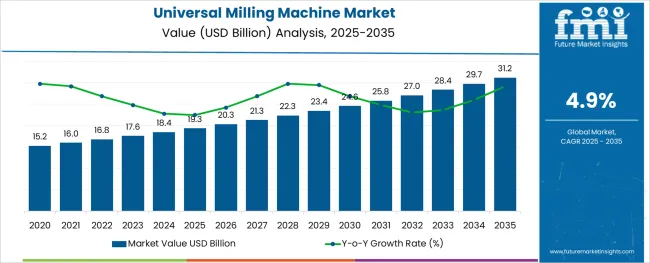
The universal milling machine market is demonstrating stable growth as industries seek advanced machining solutions to improve productivity, precision, and flexibility. Demand is being reinforced by the increasing complexity of metal components, stringent quality standards, and the necessity to optimize production cycles.
Manufacturers are focusing on machines that offer versatility and adaptability across a range of materials and geometries, enabling end users to minimize downtime and enhance operational efficiency. Future growth is anticipated to benefit from the integration of digital controls, automation, and energy-efficient designs that align with the evolving needs of modern manufacturing.
Industry players are also responding to workforce skill challenges by developing user-friendly interfaces and training support, ensuring these machines remain integral to production strategies. These factors are collectively creating an environment where innovation and performance improvements continue to open new avenues for adoption across industrial segments.
The market is segmented by Product Type, Application, and Number of Axis and region. By Product Type, the market is divided into Adjustable Cutter Head and Automated Adjustable. In terms of Application, the market is classified into Metal Industry, Plastic Industry, and Wood Industry. Based on Number of Axis, the market is segmented into 3Axis. Regionally, the market is classified into North America, Latin America, Western Europe, Eastern Europe, Balkan & Baltic Countries, Russia & Belarus, Central Asia, East Asia, South Asia & Pacific, and the Middle East & Africa.
Insights into the Adjustable Cutter Head Product Type Segment
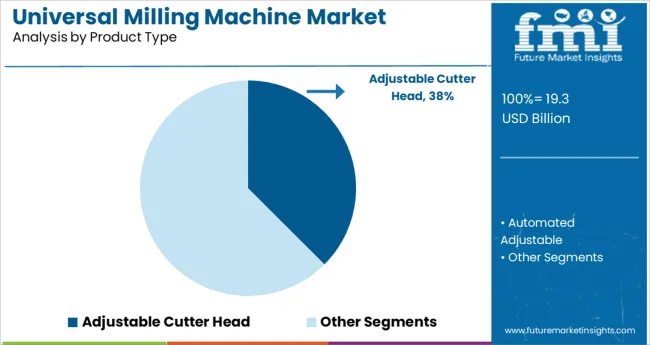
When segmented by product type, the adjustable cutter head segment is expected to hold 37.5% of the total market revenue in 2025, establishing itself as the leading product category. Its prominence has been driven by the capability to perform a wide variety of milling operations with high precision and minimal setup changes.
This adaptability has allowed operators to reduce tooling time and achieve superior surface finishes across complex parts, making it a preferred choice in high-mix, low-volume production environments. The ability to handle diverse cutting angles and adjust seamlessly between operations has enhanced productivity and reduced the need for additional fixtures.
Additionally, improvements in cutter head materials and mechanisms have increased durability and operational reliability, reinforcing this segment’s appeal to manufacturers prioritizing flexibility and cost efficiency.
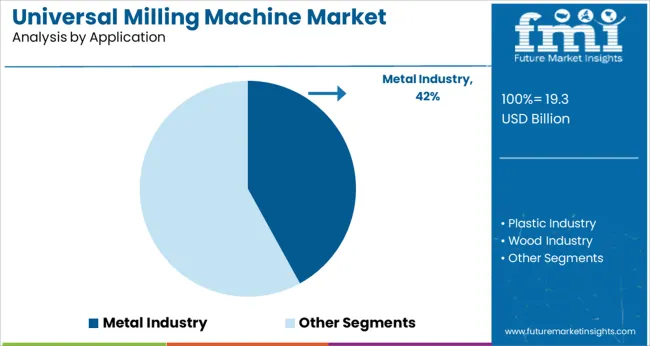
Segmented by application, the metal industry is projected to account for 42.0% of the universal milling machine market revenue in 2025, maintaining its position as the dominant end-use sector. This leadership has been underpinned by the extensive requirement for precise and efficient machining of metal components across sectors such as automotive, aerospace, and heavy equipment manufacturing.
The ability of universal milling machines to meet stringent tolerance demands, produce intricate geometries, and operate on a range of metals has made them indispensable in metalworking facilities. Increased investments in infrastructure and industrial machinery have further strengthened demand within the metal industry, where production scale and quality standards remain paramount.
The segment’s sustained growth is also supported by the push toward localized manufacturing and the adoption of advanced materials that require adaptable and robust machining solutions.
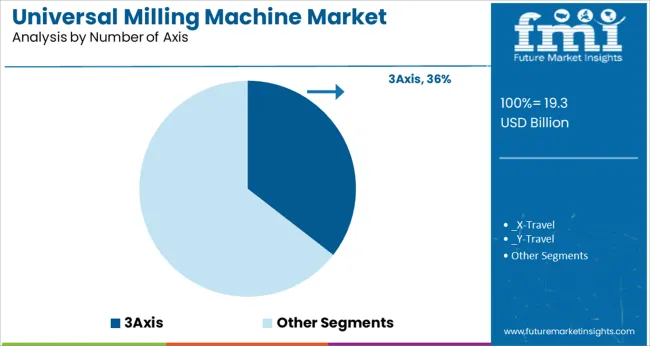
When segmented by number of axis, the 3 axis segment is forecast to capture 35.5% of the market revenue in 2025, asserting itself as the leading configuration. This dominance has been driven by its optimal balance between cost, functionality, and ease of operation, which has made it highly suitable for a broad range of milling tasks.
The simplicity of programming and maintenance, combined with the ability to execute most standard milling operations efficiently, has ensured continued preference for 3 axis machines in both small and large manufacturing setups. Enhancements in control systems and mechanical stability have improved accuracy and throughput, while maintaining affordability compared to more complex multi-axis machines.
This segment’s resilience is further reinforced by its wide applicability in workshops that prioritize reliability and versatility without the higher capital investment and skill requirements of advanced axis configurations.
According to a new report by Future Market Insights, the global universal milling machine market exhibited considerable growth at a CAGR of 4.0% during the historical period from 2020 to 2025. Increasing demand for technologically advanced mills, which is mainly being driven by rapid urbanization and industrialization is set to aid growth. Besides, the rapid expansion of the aviation and automotive industries is another crucial factor that would push sales of universal milling machines in the forecast period.
FMI states that the market is anticipated to exhibit growth at a CAGR of 4.9% in the evaluation period. Owing to increasing online activities among people, the demand for spare parts is anticipated to surge in the evaluation period. Significant improvements and technological advancements in the field of logistics would help producers to provide high-quality products quickly. Development of mobile purchasing platforms and online purchasing for automotive spare parts are also expected to boost the global universal milling market
A number of influential factors have been identified to stir the soup in the universal milling machine market. Besides the proliferating aspects prevailing in the market, lead analysts at FMI have also analyzed the restraining elements, lucrative opportunities, and upcoming threats that can pose a challenge to the progression of the universal milling machine market.
The drivers, restraints, opportunities, and threats (DROTs) identified are as follows:
DRIVERS
RESTRAINTS
OPPORTUNITIES
THREATS
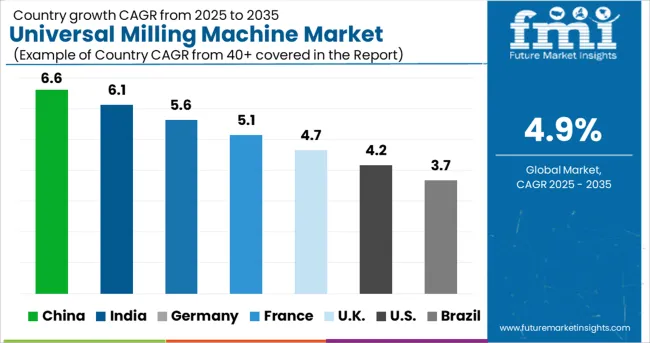
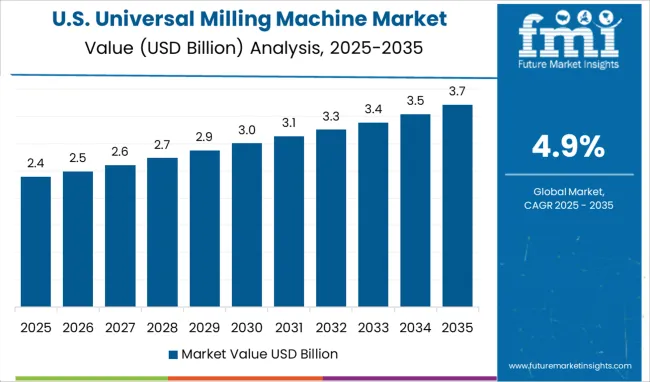
Increasing Demand for Electric Vehicles in the USA to Spur Sales of Universal Milling Head Machines
In the USA, the universal milling machine market is set to be affected by several factors. Expansion of the automotive industry is one of the major factors driving sales in the USA market. Increasing demand for electric vehicles to control pollution and global warming levels would augur well for the USA market in the evaluation period.
As per the International Energy Agency (IEA), nearly 13% of new cars sold in 2025 will be electric vehicles. In 2024, sales of electric vehicles nearly doubled to 18.4 million in 2024. Apart from that, rising demand for military equipment owing to political tension and enhancement of the Army’s strength is projected to fuel the USA market.
Universal Horizontal Milling Machines to Gain Impetus in India Amid Rising Automotive Manufacturing
A universal milling machine is a versatile piece of equipment that can be used for a wide variety of machining operations. India is a country with a rapidly growing manufacturing sector, and there is a high demand for universal milling machines. There are many opportunities for businesses to sell universal milling machines in India.
A universal milling machine is an important tool for many industries in India. The machine is used in the country to create various parts for everything- right from cars to airplanes. Besides, increasing production of automotive in the country is projected to drive the demand in the next ten years.
This provides ample opportunities for those who want to enter the field of milling machine manufacturing. There is a high demand for these machines from small- and medium-sized businesses. These businesses are looking for cost-effective ways to increase their production capacities. Universal milling machines are considered to be an ideal solution for these businesses.
Government Support to Accelerate ‘Made in China 2025’ Plan will Boost Sales of Universal Mill Grinders
Rising government investments in various sectors such as infrastructure and manufacturing in China are anticipated to drive the universal milling machine market during the evaluation period. The Chinese government has also been supporting the Made in China 2025 initiative, which primarily aims to expand the domestic manufacturing industry. Owing to the aforementioned factors, it is anticipated that demand for universal milling machines will increase significantly in China during the forecast period
Demand for Automated Adjustable Universal Mill Grinders to Surge among Spare Parts Companies
Based on product type, the automated adjustable segment is anticipated to remain at the forefront in the next ten years. This growth is attributed to the rising need for spare parts as the scrapping of engines and automobiles surges. Owing to strict norms in industrialized nations to control environmental pollution, scrap rates are high, which can result in the frequent replacement of motor vehicles, as well as their engines.
Besides, increasing the adoption of novel technologies to develop new engines such as hybrid engines would spur the growth of the segment. High demand for new vehicles with low fuel consumption, as well as rising government support to tighten emission standards is anticipated to push sales of automated adjustable universal milling machines with unique features.
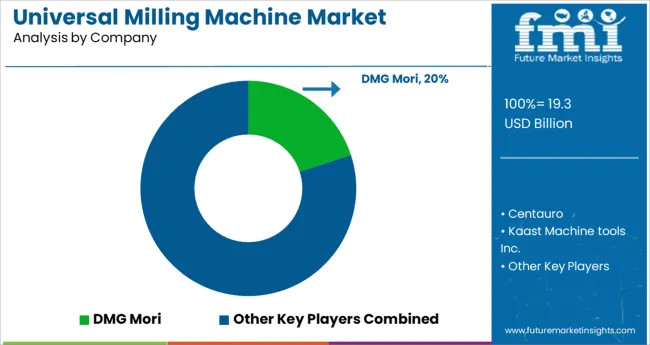
The global universal milling machine market is highly competitive with the presence of a large number of manufacturers. Key players in the market are focusing on product innovation and development to gain a competitive edge. Some of the other manufacturers are also investing in research & development activities to expand their product portfolios. In addition, leading players are adopting various strategies such as mergers & acquisitions, partnerships, and joint ventures to gain a larger share of the market.
The competitive landscape of the universal milling machine market is expected to intensify in the next ten years with the entry of new players. New entrants are set to focus on offering innovative products and solutions to customers at competitive prices.
These players are investing heavily in research & development activities to come up with advanced products. Some of the key players in the global market are Centauro, Kaast Machine tools Inc., Shenzhen Joint Industry Co., Ltd, Knuth Machine tools, DMG Mori, and Kwality Machinery Export among others.
One of the leading players operating in the global market include:
| Attribute | Details |
|---|---|
| Estimated Market Size (2025) | USD 19.3 billion |
| Projected Market Valuation (2035) | USD 31.2 billion |
| Value-based CAGR (2025 to 2035) | 4.9% |
| Forecast Period | 2025 to 2035 |
| Historical Data Available for | 2020 to 2025 |
| Market Analysis | Value (million) |
| Key Regions Covered | North America; Latin America; Europe; Asia Pacific; Oceania; Middle East and Africa (MEA) |
| Key Countries Covered | USA, Canada, Mexico, Germany, UK, France, Italy, Spain, China, Japan, India, South Korea, Australia, Brazil, Argentina, South Africa, UAE |
| Key Segments Covered | Product Type, Number of Axis, Application, Region |
| Key Companies Profiled | Centauro; Kaast Machine tools Inc.; Shenzhen Joint Industry Co., Ltd; Knuth Machine tools; DMG Mori; Kwality Machinery Export |
| Report Coverage | Market Forecast, Company Share Analysis, Competitive Landscape, Drivers, Restraints, Opportunities and Threats Analysis, Market Dynamics and Challenges, and Strategic Growth Initiatives |
The global universal milling machine market is estimated to be valued at USD 19.3 billion in 2025.
It is projected to reach USD 31.2 billion by 2035.
The market is expected to grow at a 4.9% CAGR between 2025 and 2035.
The key product types are adjustable cutter head and automated adjustable.
metal industry segment is expected to dominate with a 42.0% industry share in 2025.






Full Research Suite comprises of:
Market outlook & trends analysis
Interviews & case studies
Strategic recommendations
Vendor profiles & capabilities analysis
5-year forecasts
8 regions and 60+ country-level data splits
Market segment data splits
12 months of continuous data updates
DELIVERED AS:
PDF EXCEL ONLINE
Universal Flash Storage Market Report - Growth & Forecast 2025 to 2035
Universal Joint Shafts Market
Universal Testing Machine Market Growth – Trends & Forecast 2025-2035
Embedded Universal Integrated Circuit Card (eUICC) Market Size and Share Forecast Outlook 2025 to 2035
Integrated Universal Integrated Circuit Card (iUICC) Modules Market Size and Share Forecast Outlook 2025 to 2035
Milling Machine Market Growth – Trends & Forecast 2025 to 2035
End Milling Machine Market Report - Demand, Growth & Industry Outlook 2025 to 2035
Road Milling Machine Market Analysis and Opportunity Assessment in India Size and Share Forecast Outlook 2025 to 2035
Rice Milling Machine Market Size and Share Forecast Outlook 2025 to 2035
Tree Milling Machine Market Size and Share Forecast Outlook 2025 to 2035
Corn Milling Machine Market Size and Share Forecast Outlook 2025 to 2035
Maize Milling Machine Market Size and Share Forecast Outlook 2025 to 2035
Wheat Milling Machine Market Size and Share Forecast Outlook 2025 to 2035
Thread Milling Machine Market Size and Share Forecast Outlook 2025 to 2035
Corn Wet Milling Services Market Size, Growth, and Forecast for 2025 to 2035
Portable Milling Machine Market Size and Share Forecast Outlook 2025 to 2035
Indexable Milling Cutters Market Size and Share Forecast Outlook 2025 to 2035
Horizontal Milling Machine Market Size and Share Forecast Outlook 2025 to 2035
Desktop CNC Milling Machines Market Size and Share Forecast Outlook 2025 to 2035
Tabletop CNC Milling Machines Market Analysis - Size, Share, and Forecast Outlook 2025 to 2035

Thank you!
You will receive an email from our Business Development Manager. Please be sure to check your SPAM/JUNK folder too.
Chat With
MaRIA